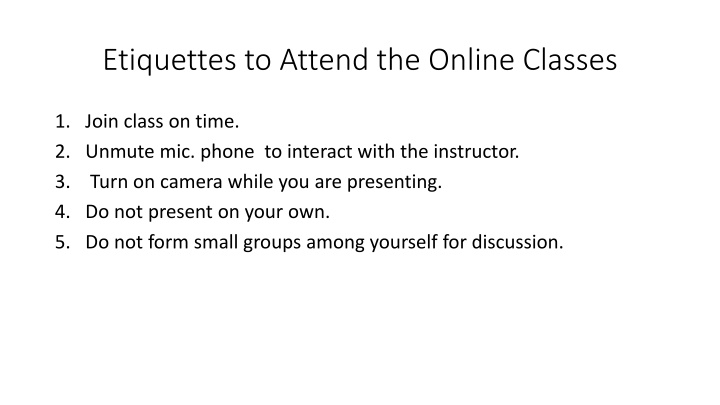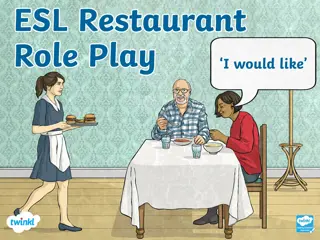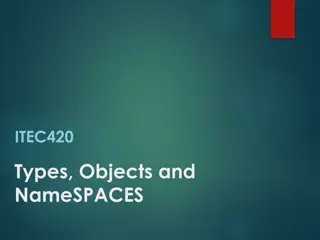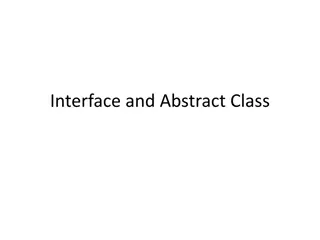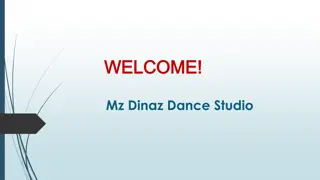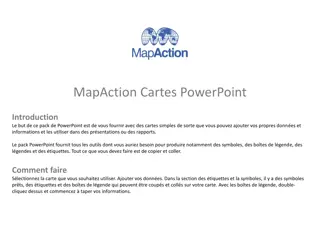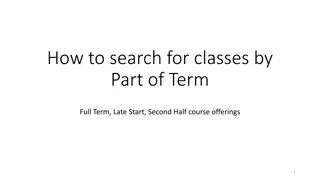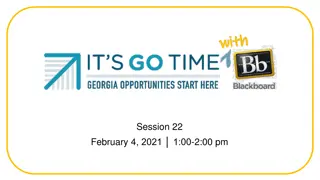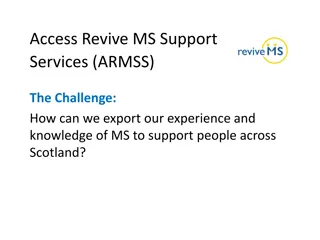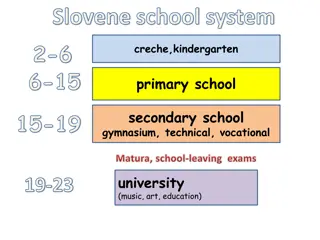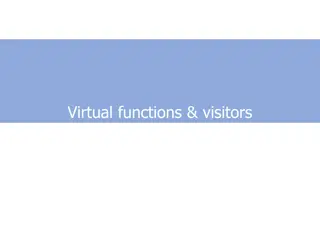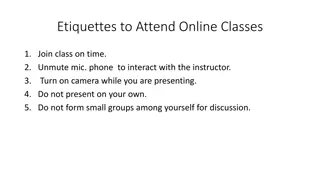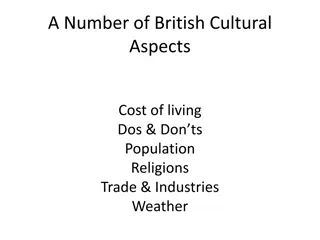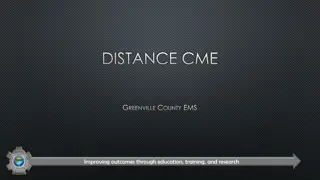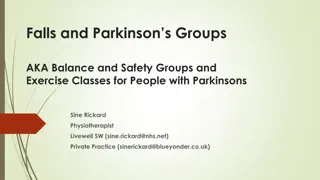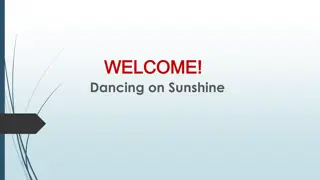Etiquettes to Attend the Online Classes
Join online classes on time, unmute mic to interact, turn on camera when presenting, avoid forming small groups, maintain communication levels, and understand flow of communication in various contexts.
Download Presentation

Please find below an Image/Link to download the presentation.
The content on the website is provided AS IS for your information and personal use only. It may not be sold, licensed, or shared on other websites without obtaining consent from the author.If you encounter any issues during the download, it is possible that the publisher has removed the file from their server.
You are allowed to download the files provided on this website for personal or commercial use, subject to the condition that they are used lawfully. All files are the property of their respective owners.
The content on the website is provided AS IS for your information and personal use only. It may not be sold, licensed, or shared on other websites without obtaining consent from the author.
E N D
Presentation Transcript
Etiquettes to Attend the Online Classes 1. Join class on time. 2. Unmute mic. phone to interact with the instructor. 3. Turn on camera while you are presenting. 4. Do not present on your own. 5. Do not form small groups among yourself for discussion.
Communicative English Course Code: HSS-S101 Deepti Agarwal Instructor
Levels of Communication Extra personal Communication Intra Personal Communication Inter Personal Communication Organisational Communication Mass Communication
Extra Personal Level Communication between human beings and non human beings. Example: Alarm Clock, Animals, Notifications, Alerts, Siri, Alexa
Intra Personal Level Communication with one self Examples: Soliloquies, Introspection
Inter Personal level Communication between two or more people. Mode: Oral, Written, and Sign Forms: Face to Face, Telephonic, Digital, Discussions Feedback: Immediate Requirements: LSRW Listening: Active/ Passive Listening Speaking Reading Writing
Organisational Level Internal Oral/Written Speech/Presentations/Meetings; Letters, Emails, Notices, Memos, Reports External Oral/ Written Meetings/ Speech/ Presentations; Letters, Emails, Reports, Proposals
Flow Of Communication Downward Upward Lateral/horizontal
Downward Flow of Communication Direction: The message flows downwards from higher rank officials to lower rank officials in an organization. Purpose of DFC: Implementation of Rules and Regulations Job Instructions and rationale Performance Feedback Procedures and practices Socialization
Merits of Downward flow of Communication Maintains Uniformity Maintains Discipline Maintains Progress Provides directions Aids in achieving goals Helps in maintaining relationship
Demerits of Downward Flow of Communication Information Overload Restrictive Environment Distortion of message Loss of Message
Upward Flow of Communication The message flows in upward direction from lower rank officials to higher rank officials in an organization. For example: Feedback forms/Question Box/RTI
Merits of Upward Flow of Communication Information about finances and accounts Information about problems and exceptions Suggestions for improvement Information about grievances and disputes Performance reports
Demerits of UFC Fear of Superiors Time lag between the communication and the action can inhibit upward communication Defensive replies of authorities No response from administrators Physical barriers between the higher and lower employees.
To improve Upward Flow of Communication The open-door policy Counselling, Attitude questionnaires, and exit interviews. Participative Techniques The grapevine
The Open Door Policy For fostering better working environment, the lower rank officials are encouraged to communicate freely with higher authorities. As the term implies, the employees with their Managers, Directors, or higher rank officials can discuss problems, provide suggestions, or discuss any sort of workplace concerns without worrying of their position in the chain of command.
Benefits of Open door policy Encourages employees to communicate with senior officials freely. Develops an environment of trust and mutual respect between employer and employee. Aids in boosting morale of the employees. Strengthens the team spirit Aids in growth and progress
Disadvantages of Open Door Policy Undervaluing less than perfect suggestions of employees. Hesitation of employees. Fear of superiors. Dishonesty of employees. Bypassing of immediate authority. Tension and strife between employees and middle management.
Counselling, Attitude questionnaires, and exit interviews Through these modes valuable information is gathered from lower rank employees.
Participative Techniques Group decision making can generate a great deal of upward communication. Examples: Union management committees Quality circles Suggestion boxes
Grapevine Informal flow of communication in an organisation. Doesn t follow a prescribed structure or rules. The message flows quickly. The flow is governed by the social and personal relationship of employees. The information flows in all directions by linking almost the entire organization. It operates in both the internal and external informal channels. It is significant to the management as it throws light on the emotional release of employees. It is cost effective. Reveals the opinions and approach of employees.
Horizontal Flow of Communication The message flows between individuals and groups on the same level of an organization. It is also called lateral flow of communication.
Merits of HFC Bridges the time gap. Enhances the coordination among members Resolves conflicts in less time
Demerits of HFC Rising of Negative Tendencies
